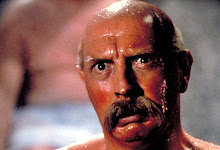
Originally run on 28 April 2009. Image via Google.
Aguirre: The Wrath of God was the sixth film directed by German auteur Werner Herzog and despite thirty years and three dozen more films, it might be his best. Aguirre could be seen as a thesis statement for the entirety of Herzog’s career, it’s the story about a single man driven to insanity and destruction by his power of will. What results is that despite its brooding, art-house posturing, Aguiree still manages to be a captivating adventure story.
The film begins in the Andes Mountains with the conquistador Gonzalo Pizarro’s quest for El Dorado, the legendary city of gold. After running short on supplies, manpower and morale, Pizarro sends one of his lieutenants, Pedro de Ursúa, along with an unbalanced soldier, Lope de Aguirre (Klaus Kinski), to try and scout the Amazon river. The foray into the Amazon is doomed from the start, and as time goes on the crew begins to succumb to the rigors of the Amazon forest. The axis of their demise isn’t the vicious, unseen natives, but rather, their comrade Aguirre, whose ambition eventually strips away his humanity.
Klaus Kinski is to Werner Herzog as Toshiro Mifune is to Akira Kurosawa, or as Ben Affleck is to Kevin Smith, I guess. Kinski is suited perfectly as the megalomaniacal conquistador, because like the character, he’s as bat-shit insane as the man he plays. The thespian’s raging tantrums are the things of legend (and the subject of at least two documentaries). His capriciousness eventually led to him threaten to leave the production, forcing Herzog (allegedly) to pull a gun on the star to keep him from departing (Herzog claims that this account is false—he claims that he only threatened to have Kinski shot and that he never pulled a piece himself). Wherever the truth lies, the actor isn’t in any position to judge, having shot the finger off of a crewmember during one of his tirades. Oddly enough, the two men worked together on another four movies, resulting in some of their most memorable work, Aguirre being the crown jewel of these endeavors.
Kinski aside, the story of Aguirre’s production was as plagued as that other great river-based epic, Apocalypse Now. The movie was shot on location in South America on a scant $370,000 budget and with a camera stolen from the University of Munich. On the DVD’s director commentary, Herzog details his trials on set with his signature brooding Teutonic monotone, and delivers one of the more edifying special features that I can recall (just You Tube his opinions on nature or the interview with Mark Kermode where he gets shot and carries on as though nothing happened).
Werner Herzog has been criticized for plenty of things, such as letting his obsessions get the better of him (not unlike many of his subjects in his fiction and non-fiction films), but he can never be accused of being a boring filmmaker. He is one of the great names of art house cinema and belongs alongside other artsy luminaries such as Jim Jarmusch and David Lynch (who produced the German’s latest film). Aguirre is the perfect example of the raw enthusiasm that he has for creating films. For those who aren’t familiar with the more esoteric side of cinema, Aguirre: The Wrath of God is a great place to start.

No comments:
Post a Comment